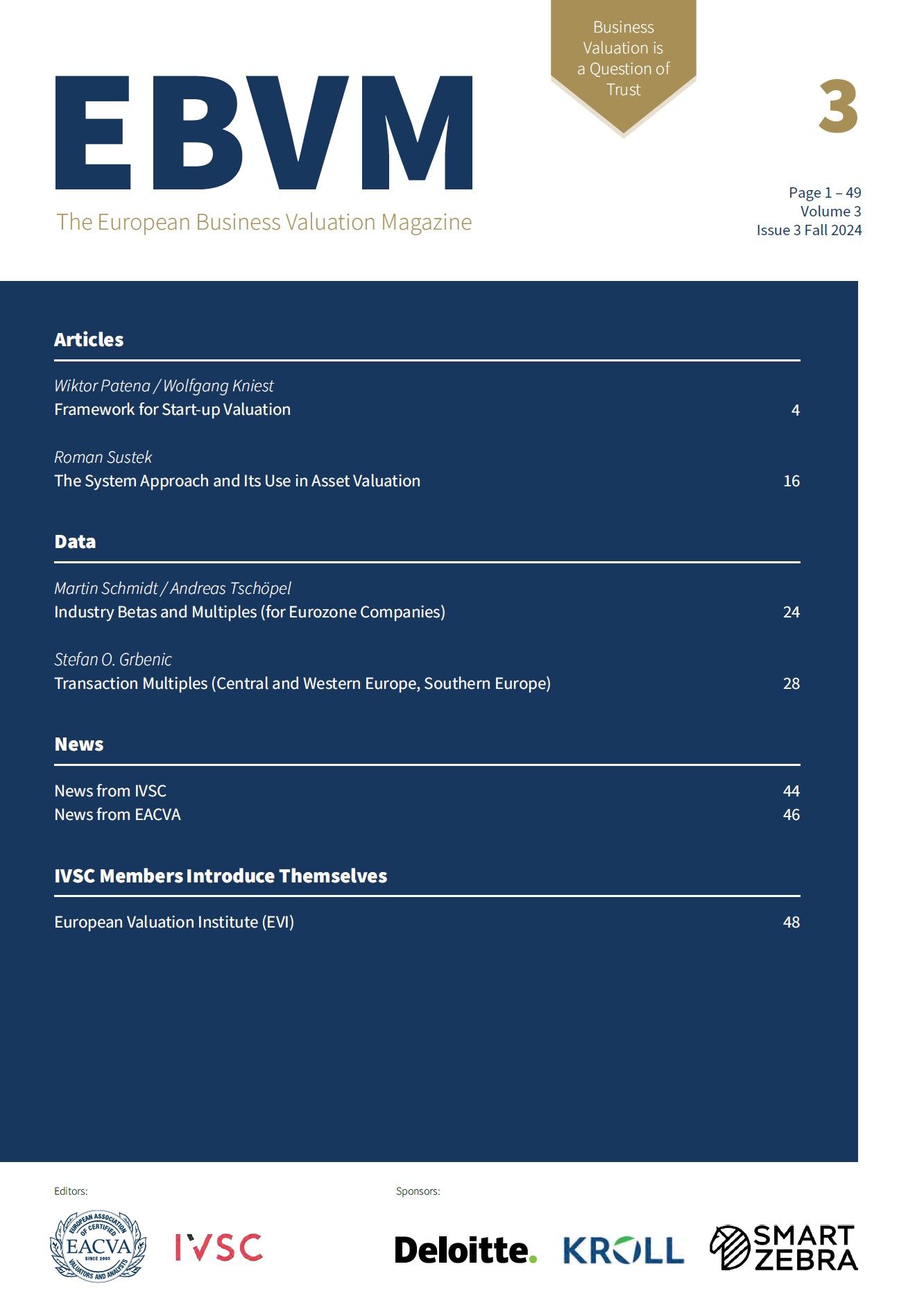European Business Valuation Magazine
Issue Fall 2024

The European Association of Certified Valuators and Analysts (EACVA) and the International Valuation Standards Council (IVSC) are pleased to present the 9th issue of the new European Business Valuation Magazine (EBVM), published in October 2024.
- Editorial: The Business Valuation “Loser’s Game” and the Big Valuation Picture
Prof. Dr. Matthias Meitner, CFA - Framework for Start-up Valuation
Dr. Wiktor Patena / Wolfgang Kniest, CVA - The System Approach and Its Use in Asset Valuation
Roman Sustek, Ph.D. - Data: Industry Betas and Multiples (for Eurozone Companies)
Dr. Martin H. Schmidt | Dr. Andreas Tschöpel, CVA, CEFA, CIIA - Data: Transaction Multiples (Central and Western Europe and Southern Europe)
Prof. Dr. Stefan O. Grbenic, StB, CVA - News from IVSC
- News from EACVA
- IVSC Members Introduce Themselves:
European Valuation Institute (EVI)
Abstracts
Our life as business valuation experts is not an easy one. We have to master capital market theory as well as well as statistics to derive proper discount rates. We have to understand taxation and commercial accounting rules in order to set up sound financial statement forecasts. We have to manage business model, competitive environment and boader market dynamics analysis in order to make or check cash flow projections, etc.
In theory, we could easily spend weeks or months with every single above-cited business discipline in every single valuation case. We could go deeper and deeper into every detail, run more and more analyses, approach the problems from yet another angle, etc. But in practice, things are quite different: Time and remuneration budget constraints, a lack of information availability and the general uncertainty about the future pose limits to our analytical efforts. And such limitations inevitably lead to our valuation works and outcomes being – by the very nature of practical circumstances – always a bit incomplete. This is quite an unsatisfying aspect of our work as valuation experts which ultimatively raises the question: how can we optimise the quality of valuation results in such an environment?
In 1970, Simon Ramo published a book called “Extraordinary Tennis for the Ordinary Tennis Player”. In this book he showed that amateur tennis is a typical loser’s game where most points are made by mistakes of the opponent player – in contrast to professional tennis where most points are made by winner shots. His advise to amateur tennis players: Just avoid making mistakes! In 1975, Charles Ellis demonstrated in his famous article “The Loser’s Game”, published in the Financial Analyst Journal, that equity investing is also a loser’s game: Due to the complexity of the world, investors do best by avoiding severe mistakes and not by trying to optime every single performance contributor. And business valuation is not different, it is also a loser’s game: The best valuation results in a world of uncertainty and complexity are achieved when keeping a holistic view rather than risking to make mistakes by wandering in a maze of details.
What does this mean for our work? While we certainly cannot fully ignore the many details of business valuation we should nevertheless step back at different points of our valuation process and have a look at the big valuation picture: Does this risk parameter really fit to our business model? Is this margin development seen at any other company in the industry? Do multiples support my DCF results? Does it all fit together? Only if we revisit these roots of valuation we can check whether it all makes sense. Don’t give away this important way of adding quality to your valuation results.
We hope you enjoy reading this EBVM issue and look forward to your feedback.
This article aims to develop a model to value companies in their initial phases of development. The premise of the article is that start-up companies are perplexing to value. Each of the standard approaches to valuation, such as income, asset or market-based method, reveals its infirmity or significant limitations when confronted with the challenge of valuing start-ups. As a result, many valuation methods yield unrealistic numbers. We are presenting a framework that creates a coherent environment for successful start-up valuation. It emphasizes the following components: fundamentals of DCF valuation, intellectual capital contributions, embedded real options, calibrated capital structure, sensitivity and scenario analysis, coherent model with iterative financial functionalities.
This article deals with the application of a systemic approach to the valuation of rights to immovable property. Emphasis is placed on a structured approach to assessing the characteristics of immovable property on which the value depends, as well as the essential characteristics of the surroundings that significantly affect the owner‘s utility and therefore the value of the property. The aim of the paper is thus to show the possibilities of using systems theory and the systems approach in solving valuation problems so that valuers can base their valuation on clear contexts that contribute to the quality of the valuation and facilitate the correct interpretation of valuation results.
All data has been obtained from the KPMG Valuation Data Source. The data source provides access to cost of capital parameters from more than 150 countries and sectors as well as peer-group-specific data from over 16,500 companies worldwide. The data covers the period from 2012 to the present. The data is updated monthly and is accessible from anywhere around the clock. See KPMG Valuation Data Source for details.
The computations of the transaction multiples are based on the transaction and company data collected from various M&A databases, with the data being driven to consistency.
We publish transaction multiples for Europe and resulting regression parameters (including transactions of the period 1 April 2021 until 31 March 2024) for the following multiples:
- Deal Enterprise Value/Sales
- Deal Enterprise Value/EBITDA
- Deal Enterprise Value/EBIT
- Deal Enterprise Value/Invested Capital